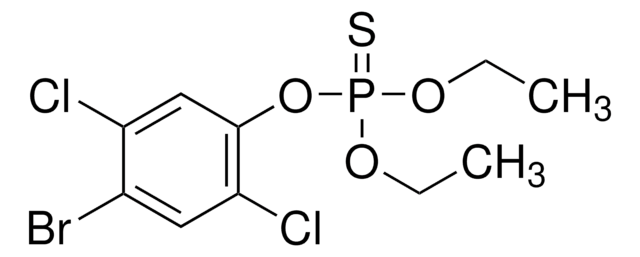Kluczowe dokumenty
PS100
Piperonylbutoxide
analytical standard
Synonim(y):
2-(2-Butoxyethoxy)ethyl (6-propylpiperonyl) ether, 4,5-Methylenedioxy-2-propylbenzyldiethyleneglycol butyl ether
About This Item
Polecane produkty
klasa czystości
analytical standard
opakowanie
ampule of 100 mg
producent / nazwa handlowa
Chem Service, Inc. PS-100
metody
HPLC: suitable
gas chromatography (GC): suitable
współczynnik refrakcji
n20/D 1.498 (lit.)
bp
155 °C/0.3 mmHg (lit.)
gęstość
1.059 g/mL at 25 °C (lit.)
Zastosowanie
agriculture
environmental
Format
neat
ciąg SMILES
CCCCOCCOCCOCc1cc2OCOc2cc1CCC
InChI
1S/C19H30O5/c1-3-5-7-20-8-9-21-10-11-22-14-17-13-19-18(23-15-24-19)12-16(17)6-4-2/h12-13H,3-11,14-15H2,1-2H3
Klucz InChI
FIPWRIJSWJWJAI-UHFFFAOYSA-N
Szukasz podobnych produktów? Odwiedź Przewodnik dotyczący porównywania produktów
Zastosowanie
Hasło ostrzegawcze
Warning
Zwroty wskazujące rodzaj zagrożenia
Zwroty wskazujące środki ostrożności
Klasyfikacja zagrożeń
Aquatic Acute 1 - Aquatic Chronic 1 - Eye Irrit. 2 - STOT SE 3
Organy docelowe
Respiratory system
Zagrożenia dodatkowe
Kod klasy składowania
10 - Combustible liquids
Klasa zagrożenia wodnego (WGK)
WGK 3
Temperatura zapłonu (°F)
339.8 °F - closed cup
Temperatura zapłonu (°C)
171 °C - closed cup
Środki ochrony indywidualnej
Eyeshields, Gloves
Wybierz jedną z najnowszych wersji:
Certyfikaty analizy (CoA)
It looks like we've run into a problem, but you can still download Certificates of Analysis from our Dokumenty section.
Proszę o kontakt, jeśli potrzebna jest pomoc Obsługa Klienta
Masz już ten produkt?
Dokumenty związane z niedawno zakupionymi produktami zostały zamieszczone w Bibliotece dokumentów.
Nasz zespół naukowców ma doświadczenie we wszystkich obszarach badań, w tym w naukach przyrodniczych, materiałoznawstwie, syntezie chemicznej, chromatografii, analityce i wielu innych dziedzinach.
Skontaktuj się z zespołem ds. pomocy technicznej










